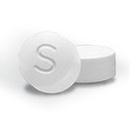Wakix Side Effects
Generic name: pitolisant
Note: This document contains side effect information about pitolisant. Some dosage forms listed on this page may not apply to the brand name Wakix.
Applies to pitolisant: oral tablet.
Serious side effects of Wakix
Along with its needed effects, pitolisant (the active ingredient contained in Wakix) may cause some unwanted effects. Although not all of these side effects may occur, if they do occur they may need medical attention.
Check with your doctor immediately if any of the following side effects occur while taking pitolisant:
Incidence not known
- Changes in behavior
- cough
- difficulty swallowing
- discouragement
- feeling sad or empty
- dizziness
- fast or irregular heartbeat
- fainting
- hives, itching, skin rash
- irritability
- lack of appetite
- loss of interest or pleasure
- puffiness or swelling of the eyelids or around the eyes, face, lips, or tongue
- seizures
- thoughts of killing oneself
- tightness in the chest
- trouble breathing
- trouble concentrating
- unusual tiredness or weakness
Other side effects of Wakix
Some side effects of pitolisant may occur that usually do not need medical attention. These side effects may go away during treatment as your body adjusts to the medicine. Also, your health care professional may be able to tell you about ways to prevent or reduce some of these side effects.
Check with your health care professional if any of the following side effects continue or are bothersome or if you have any questions about them:
More common
- Headache
- nausea
- trouble sleeping
Less common
- Anxiety
- body aches or pain
- burning, numbness, pain, or tingling in all fingers except smallest finger
- chills
- decreased appetite
- difficulty in moving
- dry mouth
- ear congestion
- fever
- headache
- loss of voice
- muscle or joint pain
- runny or stuffy nose
- seeing, hearing, or feeling things that are not there
- sneezing
- sore throat
- stomach pain or discomfort
Incidence not known
- Weight gain
For Healthcare Professionals
Applies to pitolisant: oral tablet.
General
The more commonly reported adverse reactions have included insomnia, nausea, and anxiety.[Ref]
Psychiatric
Common (1% to 10%): Insomnia, anxiety, irritability, depression, sleep disturbance, hallucinations, cataplexy
Uncommon (0.1% to 1%): Agitation, affect lability, abnormal dreams, dyssomnia, middle insomnia, initial insomnia, terminal insomnia, nervousness, tension, apathy, nightmare, restlessness, panic attack, decreased libido, increased libido
Rare (less than 0.1%): Abnormal behavior, confusional state, depressed mood, excitability, obsessive thoughts, dysphoria, hypnopompic hallucination, depressive symptom, hypnagogic hallucination, mental
Postmarketing reports: Abnormal behavior, abnormal dreams, anhedonia, bipolar disorder, depression, depressed mood, nightmare, sleep disorder, suicide attempt, suicidal ideation[Ref]
Nervous system
Common (1% to 10%): Headache, dizziness, tremor, vertigo
Uncommon (0.1% to 1%): Dyskinesia, balance disorder, cataplexy, disturbance in attention, dystonia, on and off phenomenon, migraine, psychomotor hyperactivity, restless legs syndrome, somnolence, epilepsy, bradykinesia, paraesthesia, tinnitus
Rare (less than 0.1%): Loss of consciousness, tension headache
Postmarketing reports: Epilepsy[Ref]
Gastrointestinal
Common (1% to 10%): Nausea, vomiting, dyspepsia, abdominal pain, dry mouth
Uncommon (0.1% to 1%): Diarrhea, abdominal discomfort, upper abdominal pain, constipation, gastroesophageal reflux disease, gastritis, gastrointestinal pain, hyperacidity, oral paraesthesia, stomach discomfort
Rare (less than 0.1%): Abdominal distention, dysphagia, flatulence, odynophagia, enterocolitis[Ref]
Other
Common (1% to 10%): Fatigue
Uncommon (0.1% to 1%): Asthenia, chest pain, metrorrhagia, feeling abnormal, malaise, edema, peripheral edema
Rare (less than 0.1%): Pain, spontaneous abortion, sense of oppression, abnormal general physical condition[Ref]
Cardiovascular
At a dose of 35.6 mg/day, QTc increases of 4.2 msec were observed. With exposures 3.8-fold higher a mean QTc increase of 16 msec was observed.[Ref]
Common (1% to 10%): Increased heart rate (heart rate increased; sinus tachycardia; tachycardia)
Uncommon (0.1% to 1%): Extrasystoles, bradycardia, hypertension, hypotension, hot flush, QTc prolongation
Rare (less than 0.1%): ECG repolarization abnormality, ECG T-wave inversion[Ref]
Dermatologic
Common (1% to 10%): Rash (eczema, erythema migrans, rash, urticaria)
Uncommon (0.1% to 1%): Sweating, erythema, pruritus, hyperhidrosis
Rare (less than 0.1%): Toxic skin eruption, photosensitivity, night sweats[Ref]
Genitourinary
Uncommon (0.1% to 1%): Pollakiuria[Ref]
Hepatic
Uncommon (0.1% to 1%): Increased hepatic enzymes, increased GGT[Ref]
Metabolic
Uncommon (0.1% to 1%): Decreased appetite, increased appetite, fluid retention, increased weight, decreased weight
Rare (less than 0.1%): Anorexia, hyperphagia, appetite disorder[Ref]
Musculoskeletal
Common (1% to 10%): Musculoskeletal pain ( arthralgia; back pain; carpal tunnel syndrome; limb discomfort; musculoskeletal pain; myalgia; neck pain; osteoarthritis; pain in extremity; sciatica)
Uncommon (0.1% to 1%): Arthralgia, back pain, muscle rigidity, muscular weakness, musculoskeletal pain, myalgia, pain in extremity,
Rare (less than 0.1%): Neck pain, musculoskeletal chest pain, increased creatine phosphokinase[Ref]
Ocular
Uncommon (0.1% to 1%): Reduced visual acuity, blepharospasm[Ref]
Respiratory
Common (1% to 10%): Upper respiratory tract infection (pharyngitis; rhinitis; sinusitis; upper respiratory tract infection; upper respiratory tract inflammation; viral upper respiratory tract infection)
Uncommon (0.1% to 1%): Yawning[Ref]
Frequently asked questions
More about Wakix (pitolisant)
- Check interactions
- Compare alternatives
- Pricing & coupons
- Reviews (21)
- Drug images
- Dosage information
- During pregnancy
- FDA approval history
- Drug class: CNS stimulants
- Breastfeeding
- En español
Patient resources
Professional resources
Related treatment guides
References
1. Svendsen UG, Ibsen H, Rasmussen S, Leth A, Nielsen MD, Dige-Petersen H, Giese J. Effects of combined therapy with amiloride and hydrochlorothiazide on plasma and total body potassium, blood pressure, and the renin- angiotensin-aldosterone system in hypertensive patients. Eur J Clin Pharmacol. 1986;30:151-6.
2. Cerner Multum, Inc. UK Summary of Product Characteristics.
3. Product Information. Wakix (pitolisant). Harmony Biosciences, LLC. 2019.
Further information
Always consult your healthcare provider to ensure the information displayed on this page applies to your personal circumstances.
Some side effects may not be reported. You may report them to the FDA.

